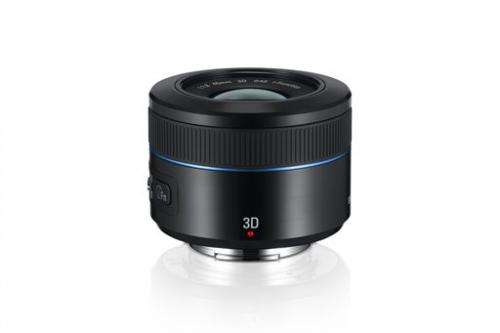Gadget Watch: Samsung lens flips from 2-D to 3-D

Cameras that can record in 3-D are usually pretty complicated, sporting two lenses instead of one, to mimic human binocular vision. Samsung says it has a more elegant solution: a single lens that can go from 2-D to 3-D mode with the flip of a switch.
Samsung Electronics Co. is showing off the new lens at the International CES show in Las Vegas, where gadget makers showcase their latest smartphones, tablet computers and other consumer-electronic devices.
ABOUT THE PRODUCT: The lens is an optional accessory for Samsung's new NX300 camera, the latest in the company's NX line of compact cameras with interchangeable lenses. Think of the line as a scaled-down equivalent of the digital single-lens reflex camera, or DSLR, which are more versatile and more expensive than point-and-shoot cameras.
The camera will record video, including 3-D video, on its 20-megapixel sensor. Any 3-D TV can play back the 3-D movies.
HOW THE LENS WORKS: A switch on the lens flips an extra shutter into the path of the light through the lens. The shutter has two sides, allowing the single lens to act as if it were two, offset from each other by a short distance.
When you snap a shot in 3-D, the camera looks quickly through one side of the front lens and records an image. It then switches quickly to the other side to record another exposure of the same subject from a slightly different angle.
LIMITATIONS: The lens is no bigger than a regular one, which limits the 3-D effect. Normally, the two lenses that form a 3-D camera's "eyes" are a few inches apart. In this case, the "eyes" are less than an inch apart, so it doesn't create a strong 3-D effect with subjects that are farther away than about 6 feet.
It's not a zoom lens. The focal length is fixed at 45 millimeters, making it a short telephoto lens suitable for portraits. The maximum aperture in 2-D mode is 1.8, which means the lens can create strong background blur and make the subject stand out from the background. The blur effect is weaker in 3-D mode, but the 3-D effect in itself makes the subject jump out.
AVAILABILITY: The NX300 camera will go on sale in March for $750 and will include a standard zoom lens. The 3-D lens will be sold separately for $500 and will be available at the same time.
Copyright 2013 The Associated Press. All rights reserved. This material may not be published, broadcast, rewritten or redistributed.


















